What to do? As the group turned southward, B-24D Pilot 1st Lt. John D. Palm from Lower Valley, Texas, assumed his place in the formation, on the left end of the second wave seeking the Romana Americana Refinery. But Palm’s navigator insisted the group had turned too early and was on the wrong course. Palm realized the plan was all fouled up. Having come this far to hit vital strategic targets, he broke formation and turned to the east, leaving the protection of the group as he sought to make the bombs carried over a thousand miles from North Africa count against the oil refinery targets in Ploesti, Romania.
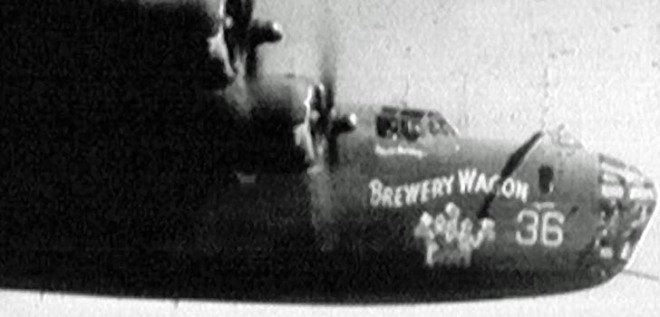
Today marks the 77th anniversary of Operation Tidal Wave, flown on Sunday, 1 August 1943, the epic low-level raid on the oil refineries which fueled a significant part of Axis oil needs for mechanized warfare. Five groups of USAAF B-24D Liberator heavy bombers flew northward from North Africa across the Mediterranean and then northeast across the Balkans to approach Romania from the west; 178 aircraft set out on the mission and the plan didn’t go quite as well as hoped, fracturing along the way to mechanical challenges, human error and chance.
Still, the low flying Liberators, striking targets at treetop level or lower, did some serious damage, like knocking out the only Romanian refinery producing aviation-quality fuel, and demonstrated the willingness, bravery and capability of Allied aircrew to attack difficult targets; five medals of Honor were awarded to men who flew this ferocious combat mission; all who flew but one (an RAF officer) received the Distinguished Flying Cross.
The first B-24 to initiate an attack against the refineries, B-24D-25-CO, serial number 41-24294 of the 512th Bomb Squadron, 376th Bomb Group, Brewery Wagon. This aircraft was delivered to the USAAF in standard olive drab over neutral gray camouflage paint in December, 1942 and out of all the locations in a world war it could have gone it eventually found its way to North Africa where it was assigned to the 376th Bomb Group.
The aircraft was given the number 36 from the serial reserved for the 512th Bomb Squadron. The number was displayed on both sides of the nose and on the outboard sides of the twin tail. According to the book by William R. Bradle, “The Daring World War II Raid on Ploesti” (Pelican Publishing Co., 2017), the name Brewery Wagon was given to the ship by its regular pilot, Robert H. Storz, who was the son of a prominent beer brewer in Omaha, Nebraska.
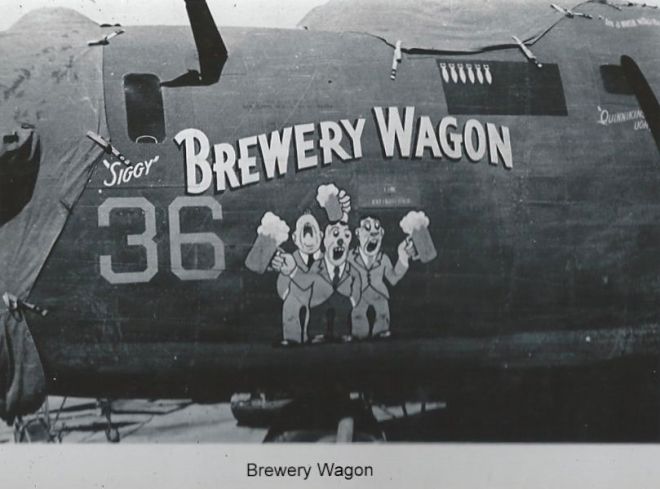
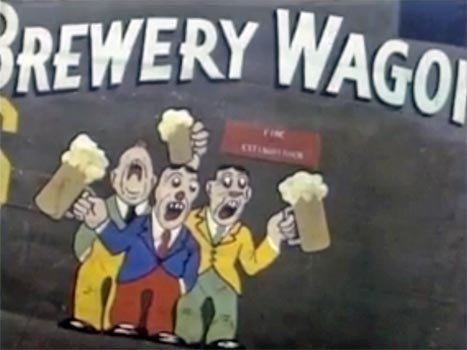
Brewery Wagon flew her first combat mission on 1 May 1943 against port facilities at Reggio, Italy though the mission was aborted due to weather. The aircraft soon developed a reputation for being a kind of a lemon, mechanical issues which were noted by four different pilots who flew the ship in its first 16 combat missions, five of which were aborted for mechanical reasons; one of her pilots was killed in combat during a mission on 21 June 1943 (1st Lt. Reynolds).
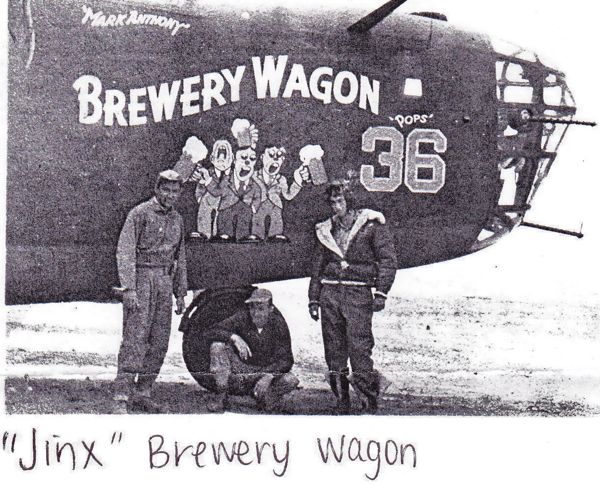
When Palm and his crew were assigned Brewery Wagon for her 17th and ultimately final combat mission, they were unhappy about it – one report says as the crew approached the aircraft one of them even threw rocks at it. Nevertheless, they climbed aboard and took off at dawn on the mission.

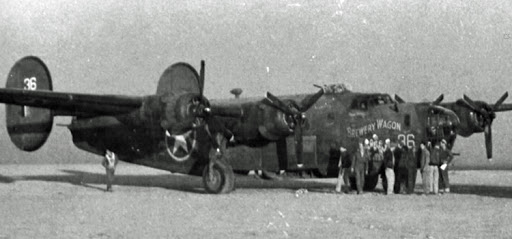
Enroute to Romania, Brewery Wagon flew in close formation with two other squadron ships, #28 “Wongo Wongo” flown by 1st Lt Brian Flavelle and Lt. Guy Iovine in # 23 “Desert Lily”. Then “Wongo Wongo” mysteriously up and crashed into the sea with its entire crew lost shortly before the 376th finished crossing the Mediterranean. Lovine, a friend of Flavelle, left formation nearly hitting “Brewery Wagon” and followed “Wongo Wongo down and circling to see if there were any survivors. “Brewery Wagon and the rest of the 376th Bomb Group continued on the mission and Iovine, unable to catch up then aborted the mission.
Now over Romania solo and speeding along at 200 feet, “Brewery Wagon” was also the first B-24 shot down over Romania. As Palm and crew flew low across the Romanian countryside they emerged from a rain cloud and were taken under fire by anti-aircraft guns as they crossed the outer ring of defenses around Ploesti.
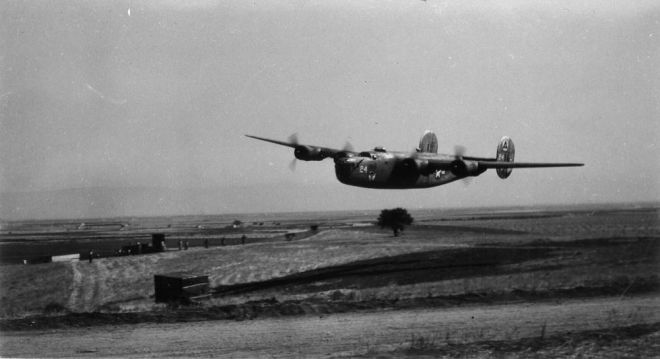
As Brewery Wagon crossed into the inner circle of defense she began to be hit, primarily by rapid-firing 20mm light anti-aircraft guns. The nose was hit by flak which either fatally wounded or killed the bombardier 2nd Lt. Robert W. Merrell (from Los Angeles, California and not a regular member of the Palm crew and on his first combat mission)outright and wounded or mortally wounded the navigator 2nd Lt. William M. Wright from Forney, Texas who would pay the ultimate price for his accurate navigation. Waist gunner S/Sgt Snyder was wounded by a hit that part of the plane.
Additional hits knocked out one of four engines and damaged another two – the bomber couldn’t stay in the air with such reduced power and Palm turned to the south to escape the deadly fire and attack the nearest refinery he could find. He recalled later: “By then I didn’t give a damn whose refinery it was! It was a refinery and by God I was going to get it come hell or high water!”
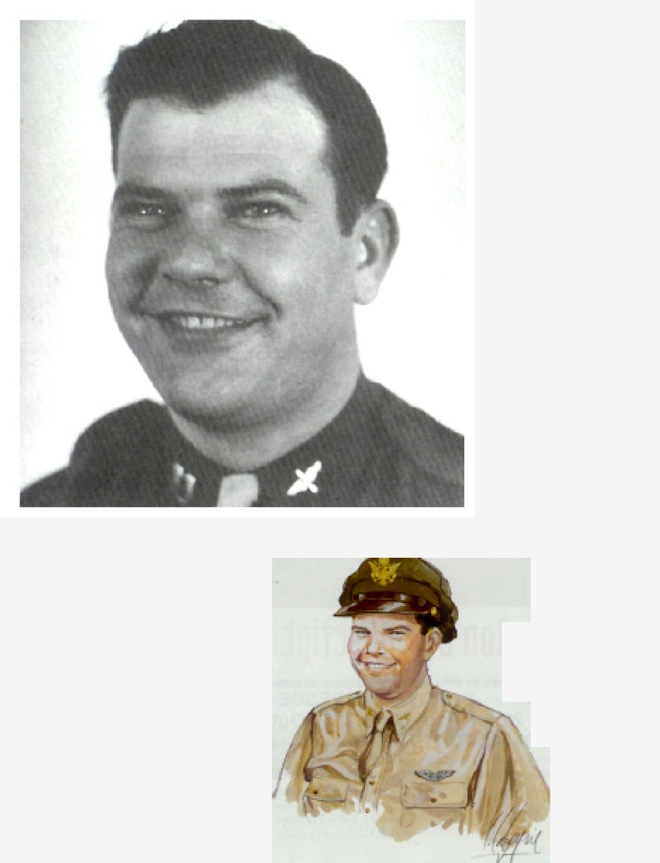
Unfortunately for him, a German Me-109G fighter piloted by Hauptmann (Captain) Wilhelm Steinmann who commanded the 1st Staffel of JG 4 saw Brewery Wagon and attacked, hitting the B-24 with 20mm cannon and 7.92mm machine gun fire in a pass from the rear, hitting along the back of the aircraft and the wings.
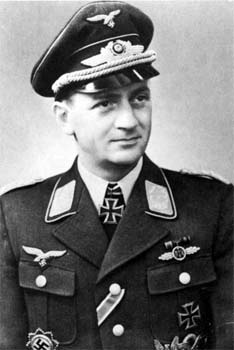
The swift fighter passed over the bomber and went ahead, turned around and made a head-on pass hitting the nose and cockpit area, the right wing and the two engines there. The attack wounded the men in the greenhouse (again) and cockpit – a 20mm shell the hit Palm himself; he was seriously injured in the blast, with his right foot essentially blown off the rudder pedal. Co-pilot Love was wounded by shell fragments.
Palm’s co-pilot 2nd Lt. William F. Love from Los Angeles, California, Somehow the wounded bomber had enough momentum to allow the pilots to put the ship into a sharp bank and clear some refinery smokestacks. Palm leveled the aircraft and jettisoned the bombs via emergency release. crash-landed his crippled ship in a cornfield near Tatarani, just south of Ploesti near the Ploesti-Bucharest railroad line. (Note, the location is about 300 meters (about three B-24 wingspans) from the Pensiunea la Gina hotel, on Str. Intrarea Gaterului, nr. 1 in the Southwest edge of Ploiesti)
The co-pilot’s quick thinking averted a greater catastrophe when he activated the engine fire extinguishers which prevented the formerly burning engines on the right wing from spreading fire to the rest of the aircraft. Like many B-24s it folded up badly and the nose with the bombardier and navigator was crushed.

The side window of the cockpit canopy jarred loose by pilot Palm and he tugged at it to make an opening: ”With the adrenaline flowing, I was able to pull the thing in. My leg was still attached by a small thread of flesh. I took the leg and laid it across my lap and dove out of the airplane. I think I was the first man out of the ship!”
Seven other crewmembers emerged from the wreck and all become prisoners of war. In addition to pilots Palm and Love, these eight survivors included flight engineer T/Sgt Alexander P. Rockinson (Canal Fulton, Ohio), radio operator T/Sgt Harold Block (Brooklyn, New York), gunners T/Sgt Austin D. Chastain (Siloam Springs, Arkansas), S/Sgt Clay E. Snyder (Paden City, West Virginia), S/Sgt William E. Thompson (St. Cloud, Florida) and tail gunner S/Sgt Dallas A. Robertson (St. Louis, Missouri).
Co-pilot Love recalled being captured by the Germans “I was prevented from returning to the ship by the German soldiers who captured us, however I persuaded two of them to go to the nose section to see if they could be of assistance. I watched them do this. One went in as far as he could. They reported that both men were dead. This was also the report of two more men sent about 30 minutes later by the German officer in charge of the station to which we were taken. It is my firm belief that Lt Merrell was killed either by enemy gunfire over the target or a few seconds later when our aircraft crash-landed.” Another crew member recalled about the bombardier Merrell that he “just heard he was blown all to pieces by flak, told to us by Romanians.”
The survivors of the crew ultimately became prisoners of war in Romanian captivity. The crew received medical aid after their ordeal such as tail gunner S/Sgt Dallas A. Robertson from St. Louis, Missouri who had a 20-mm cannon shell splinter removed from his cranium. Lt. Palm was taken to Bucharest and would lose his mangled right leg. A little over a year later they would be among the 1,173 airmen repatriated in Operation Reunion (aka Operation Gunn) after Romania joined the Allies.
So on this 1 August 2020, we salute the crew of the “Brewery Wagon” for their determination to make a difference in their part of the war. The ship may have been a sort of lemon in its brief three months of combat service, but on the big day and a brave crew it made it all the way to Ploesti.
References
Freeman, Roger, The Ploesti Raid: Through the Lens, Battle of Britain International Limited/After the Battle Magazine, London, 2004
Hill, Michael, Black Sunday: Ploesti, Schiffer Military/Aviation Military, Atglen, PA 1993
Brewery Wagon combat missions list, at: https://warbirds.fandom.com/wiki/B-24D_(Brewery_Wagon)_41-24294?fbclid=IwAR3v_J8-jBySOfCpPmy4xT-wkH5Zz06R1HmOYgVadIu3rmMO80JGSqvzH6A
Missing Air Crew Report Number 154
John D. Palm image at: http://www.americanairmuseum.com/person/120508
Wilhelm Steinmann image at: https://www.luftwaffe.cz/steinmann.html
Ploesti aircrew roster at: http://ploesti.com/roster.pdf
Storz Brewing Company, at: https://en.wikipedia.org/wiki/Storz_Brewing_Company?fbclid=IwAR2GNdnfRGnQ7BDkeCavI8l9tGr70H_KlFJyZc9QrSFnga_BUYBgbNuXKrg
Storz Beer info at: https://www.rustycans.com/COM/month1104.html?fbclid=IwAR3AdsokHnHbe7XVe9uwqW54yiHwClftErMLDssZZq402KcZx1THvrZxoUk
One thought on “The Brewery Wagon’s Final Ride”